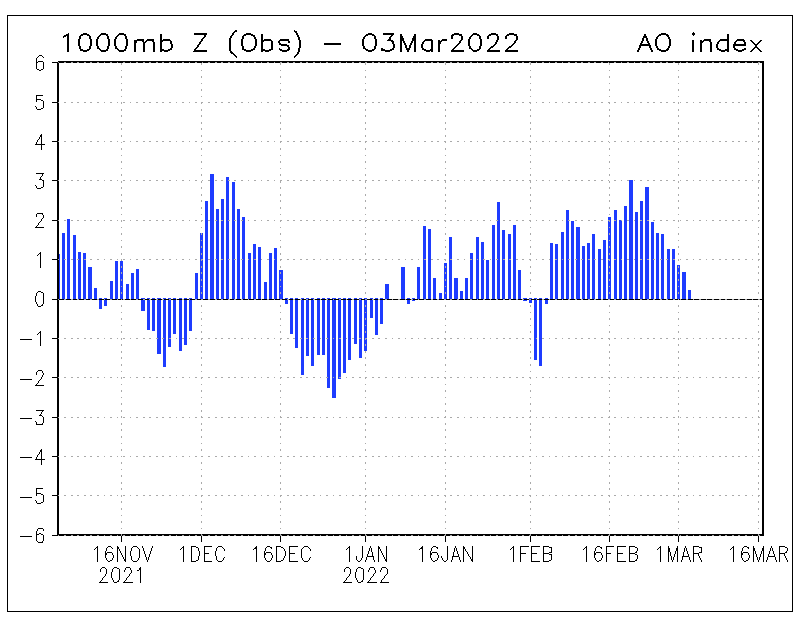
That was at $3.7250.
We followed up on the 25th with:
There was a reason we posted the temperature anomaly map last week, the first time since January 2013.Now get this, the Arctic Oscillation is still in it's positive, warmer, phase. Here's the current index from NOAA's Climate Prediction Center:
$3.77 settle, up 7 cents....

And here is James Hansen, former head of NASA's Goddard lab explaining the AO:
"The degree to which Arctic air penetrates into middle latitudes is related to the AO index, which is defined by surface atmospheric pressure patterns. When the AO index is positive, surface pressure is low in the polar region. This helps the middle latitude jet stream to blow strongly and consistently from west to east, thus keeping cold Arctic air locked in the polar region. When the AO index is negative, there tends to be high pressure in the polar region, weaker zonal winds, and greater movement of frigid polar air into middle latitudes."Nat gas front futures $3.96.
From Bloomberg:
A wave of polar air is sweeping into the U.S. with snow and ice, sending energy use soaring and threatening to damage crops and disrupt natural gas production.The last time we did the AO thing:
Temperatures will plummet as the cold moves south, east and west from Canada. Readings in Chicago will tumble from today’s high of 57 degrees Fahrenheit (14 Celsius) to a low of 5 degrees next week, according to forecasts.
“It’s pretty impressive stuff; it’s going to set some records,” said Rob Carolan, owner of Hometown Forecast Services Inc. in Nashua, New Hampshire. “A lot of the country is going to be feeling the effects of the cold weather by Monday.”
Below-normal temperatures, especially in eastern and Midwestern cities, tend to increase energy consumption as more people heat homes and businesses. Arctic temperatures can also crimp gas production by creating freeze offs, in which ice forming in and around wells can disrupt output.
As of today, there probably won’t be widespread disruptions in natural gas production, said Matt Rogers, president of the Commodity Weather Group LLC in Bethesda, Maryland.
“This is a very impressive air mass,” Rogers said in e-mail. “I’d lean against major damage at this time, but do agree the risk of some problems has increased this morning.”...MORE
Jan. 9, 2012
Dear Europe: Arctic Oscillation About to Go Negative, Try to Stay Warm
Jan. 30, 2012
Brrrr: Arctic Oscillation Goes Deeply Negative, Here Comes Winter
Which resulted in:
Feb. 14
Death toll rises to 600 in European cold snap
A total 824 deaths from freezing in February 2012
AonBenfield 11 page PDF
Serious business.